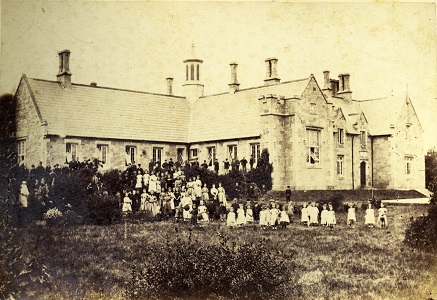THE MODEL SCHOOL

by Tom Kenny
The Model School on Newcastle Road was built in 1849/50 for a cost of £2,533 plus £800 for the furniture. It was one of a series of Model Schools built around that time and was the only one constructed under budget. It opened in July 1852, 170 years ago this month. It catered for Protestant children.
In 1904, the Chief Secretary of Ireland, Mr. Wyndham, declared in Parliament that the average attendance in the school for the year 1903 was 95 and the expenditure out of public funds was £482. 11s.
60 years after it opened, Frances Moffatt entered as a pupil and she described it thus: “the school I went to in Galway was not a very modern one. It was a mixed school and very prettily situated. Anybody seeing it from the road would never think it was a school but a private building. For the entrance there is just a small iron gate and a path which is styled ‘The Avenue’. Each side of the path there are different trees which make it very pleasant … some years ago, there used to be a bell on top of the school, but that has long been done away with”.
The backgrounds of the parents of the pupils varied from the artisan to the professional and there was a wide range of ability among the students, not necessarily dependent on their social status. It was certainly mixed ability teaching. There was a female teacher who taught the kids up to the age of eight, and then they graduated into the principal Mr. Brown’s class, where they could stay until the age of fourteen. They were all taught in the same large room which was very high, lit by four very tall windows, all on the south side. The headmaster had a large oak desk at the end of the room with a lift up lid on which lay the cane, occasionally used. Beside the desk was an enormous blackboard on an easel, a Mercator projection map of the world hung on the wall and there was a large globe on the mantelpiece. Two tall deal cupboards held all their communal books.
Pupils bought their own books which were carried to and from school each day in real leather satchels which were always kept well polished. There was no artificial light in the school, no heating pipes, just a coal fire which made it look very cosy. In a varied curriculum, the boys did woodwork and the girls did cookery under the supervision of the infants’ mistress, for which purpose they had a nice room fitted up with cupboards, a sink and a gas stove. The girls always ate what they cooked and invariably looked forward to cookery day. Physical education was an important part of their education and some singing was also taught.
The headmaster and his family had accommodation on the first floor of the building.
In 1913, ball point pens had not been invented, fountain pens were forbidden so pen nibs were of great importance. The inkwells on the desks had brass lids. There was only one dictionary in the school, a large and heavy tome. Dictionary work was very popular, under the guise of consulting about the meaning of a word, it was possible to do quite a bit of gossiping, especially if one could manage to pair off with one’s best friend. The pupils regularly acted out scenes from Shakespearean plays which gave real meaning to the text.
Our photograph of the school and some of its pupils was given to us by the Chetham Library in Manchester. It was originally taken c.1865, just a few years after the school opened.
The school eventually closed and was taken over by the Chemistry Department of UCG who converted it into a lecture hall and laboratories. The top room on the very far right was Professor Frank Coll’s office and was said to be haunted. The Patrician Brothers had a field at the back of UCG, near Distillery Road, which was regularly used as a football pitch by the Street Leagues. Much of it was surrounded by a high wall. The Brothers came to some sort of arrangement with the College whereby they exchanged this field for the Model School. The Brothers then demolished the school and built a block of apartments which is still there, but is today in the form of an office block used by the HSE.
Much of the above information came from a delightful book by Frances Moffatt entitled “I also am of Ireland" which is long out of print. She attended the Model School and also wrote about aspects of Galway life in the early part of the last century.
